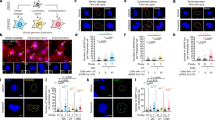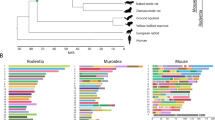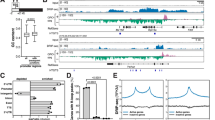Abstract
We recently proposed a DNA replication–based mechanism of fork stalling and template switching (FoSTeS) to explain the complex genomic rearrangements associated with a dysmyelinating central nervous system disorder in humans1. The FoSTeS mechanism has been further generalized and molecular mechanistic details have been provided in the microhomology-mediated break-induced replication (MMBIR) model that may underlie many structural variations in genomes from all domains of life2. Here we provide evidence that human genomic rearrangements ranging in size from several megabases to a few hundred base pairs can be generated by FoSTeS/MMBIR. Furthermore, we show that FoSTeS/MMBIR-mediated rearrangements can occur mitotically and can result in duplication or triplication of individual genes or even rearrangements of single exons. The FoSTeS/MMBIR mechanism can explain both the gene duplication-divergence hypothesis3 and exon shuffling4, suggesting an important role in both genome and single-gene evolution.
This is a preview of subscription content, access via your institution
Access options
Subscribe to this journal
Receive 12 print issues and online access
$209.00 per year
only $17.42 per issue
Buy this article
- Purchase on Springer Link
- Instant access to full article PDF
Prices may be subject to local taxes which are calculated during checkout




Similar content being viewed by others
References
Lee, J.A., Carvalho, C.M. & Lupski, J.R. A DNA replication mechanism for generating nonrecurrent rearrangements associated with genomic disorders. Cell 131, 1235–1247 (2007).
Hastings, P.J., Ira, G. & Lupski, J.R. A microhomology-mediated break-induced replication model for the origin of human copy number variation. PLoS Genet. 5, e1000327 (2009).
Ohno, S. Evolution by Gene Duplication (Springer-Verlag, Berlin, 1970).
Gilbert, W. Why genes in pieces? Nature 271, 501 (1978).
Iafrate, A.J. et al. Detection of large-scale variation in the human genome. Nat. Genet. 36, 949–951 (2004).
Sebat, J. et al. Large-scale copy number polymorphism in the human genome. Science 305, 525–528 (2004).
Redon, R. et al. Global variation in copy number in the human genome. Nature 444, 444–454 (2006).
Feuk, L., Carson, A.R. & Scherer, S.W. Structural variation in the human genome. Nat. Rev. Genet. 7, 85–97 (2006).
Flores, M. et al. Recurrent DNA inversion rearrangements in the human genome. Proc. Natl. Acad. Sci. USA 104, 6099–6106 (2007).
Korbel, J.O. et al. Paired-end mapping reveals extensive structural variation in the human genome. Science 318, 420–426 (2007).
Kidd, J.M. et al. Mapping and sequencing of structural variation from eight human genomes. Nature 453, 56–64 (2008).
Perry, G.H. et al. The fine-scale and complex architecture of human copy-number variation. Am. J. Hum. Genet. 82, 685–695 (2008).
Gu, W., Zhang, F. & Lupski, J.R. Mechanisms for human genomic rearrangements. PathoGenetics 1, 4 (2008).
Stankiewicz, P. & Lupski, J.R. Genome architecture, rearrangements and genomic disorders. Trends Genet. 18, 74–82 (2002).
Lieber, M.R. The mechanism of human nonhomologous DNA end joining. J. Biol. Chem. 283, 1–5 (2008).
Kitamura, E., Blow, J.J. & Tanaka, T.U. Live-cell imaging reveals replication of individual replicons in eukaryotic replication factories. Cell 125, 1297–1308 (2006).
Slack, A., Thornton, P.C., Magner, D.B., Rosenberg, S.M. & Hastings, P.J. On the mechanism of gene amplification induced under stress in Escherichia coli. PLoS Genet. 2, e48 (2006).
Arlt, M.F. et al. Replication stress induces genome-wide copy number changes in human cells that resemble polymorphic and pathogenic variants. Am. J. Hum. Genet. 84, 339–350 (2009).
Zhang, F., Carvalho, C.M.B. & Lupski, J.R. Complex human chromosomal and genomic rearrangements. Trends Genet. (in the press).
Chen, J.M., Chuzhanova, N., Stenson, P.D., Ferec, C. & Cooper, D.N. Complex gene rearrangements caused by serial replication slippage. Hum. Mutat. 26, 125–134 (2005).
Vissers, L.E. et al. Complex chromosome 17p rearrangements associated with low-copy repeats in two patients with congenital anomalies. Hum. Genet. 121, 697–709 (2007).
Tuzun, E. et al. Fine-scale structural variation of the human genome. Nat. Genet. 37, 727–732 (2005).
Bailey, J.A., Liu, G. & Eichler, E.E. An Alu transposition model for the origin and expansion of human segmental duplications. Am. J. Hum. Genet. 73, 823–834 (2003).
Sen, S.K. et al. Human genomic deletions mediated by recombination between Alu elements. Am. J. Hum. Genet. 79, 41–53 (2006).
Lupski, J.R. & Chance, P.F. Hereditary motor and sensory neuropathies involving altered dosage or mutation of PMP22: the CMT1A duplication and HNPP deletion. in Peripheral Neuropathy (eds. Dyck, P.J. and Thomas, P.K.). 1659–1680 (Elsevier Science, Philadelphia, 2005).
Payen, C., Koszul, R., Dujon, B. & Fischer, G. Segmental duplications arise from Pol32-dependent repair of broken forks through two alternative replication-based mechanisms. PLoS Genet. 4, e1000175 (2008).
Smith, C.E., Llorente, B. & Symington, L.S. Template switching during break-induced replication. Nature 447, 102–105 (2007).
Lydeard, J.R., Jain, S., Yamaguchi, M. & Haber, J.E. Break-induced replication and telomerase-independent telomere maintenance require Pol32. Nature 448, 820–823 (2007).
Long, M. Evolution of novel genes. Curr. Opin. Genet. Dev. 11, 673–680 (2001).
van Rijk, A.A., de Jong, W.W. & Bloemendal, H. Exon shuffling mimicked in cell culture. Proc. Natl. Acad. Sci. USA 96, 8074–8079 (1999).
Jones, J.M. et al. The mouse neurological mutant flailer expresses a novel hybrid gene derived by exon shuffling between Gnb5 and Myo5a. Hum. Mol. Genet. 9, 821–828 (2000).
Bi, W. et al. Increased LIS1 expression affects human and mouse brain development. Nat. Genet. 41, 168–177 (2009).
Carvalho, C.M. et al. Complex rearrangements in patients with duplications of MECP2 can occur by fork stalling and template switching. Hum. Mol. Genet. 18, 2188–2203 (2009).
Potocki, L. et al. Characterization of Potocki-Lupski syndrome (dup(17)(p11.2p11.2)) and delineation of a dosage-sensitive critical interval that can convey an autism phenotype. Am. J. Hum. Genet. 80, 633–649 (2007).
Doco-Fenzy, M. et al. The clinical spectrum associated with a chromosome 17 short arm proximal duplication (dup 17p11.2) in three patients. Am. J. Med. Genet. A 146, 917–924 (2008).
Acknowledgements
We thank all participating subjects and families for their kind cooperation in the study. We also thank W. Bi, W. Gu, J.A. Lee and P. Stankiewicz for their critical reviews and C.M.B. Carvalho and M.A. Withers for their assistance. This work was supported in part by the Charcot Marie Tooth Association and the National Institute of Neurological Disorders and Stroke (NINDS, NIH).
Author information
Authors and Affiliations
Contributions
F.Z., M.K. and J.R.L. designed and interpreted the experiments; F.Z. and M.K. performed the experiments. A.M.C. provided clinical data; A.M.C., C.F.T. and S.D.B. provided subject samples; C.F.T. and S.D.B. provided MLPA data; F.Z. and J.R.L. wrote the manuscript.
Corresponding author
Ethics declarations
Competing interests
J.R.L. is a consultant for Athena Diagnostics, 23andMe and Ion Torrent Systems Inc., and holds multiple US and European patents for DNA diagnostics. Furthermore, the Department of Molecular and Human Genetics at Baylor College of Medicine derives revenue from molecular diagnostic testing (MGL, http://www.bcm.edu/geneticlabs/).
Supplementary information
Supplementary Text and Figures
Supplementary Tables 1–4 and Supplementary Figures 1–10 (PDF 868 kb)
Rights and permissions
About this article
Cite this article
Zhang, F., Khajavi, M., Connolly, A. et al. The DNA replication FoSTeS/MMBIR mechanism can generate genomic, genic and exonic complex rearrangements in humans. Nat Genet 41, 849–853 (2009). https://doi.org/10.1038/ng.399
Received:
Accepted:
Published:
Issue Date:
DOI: https://doi.org/10.1038/ng.399
This article is cited by
-
High level of complexity and global diversity of the 3q29 locus revealed by optical mapping and long-read sequencing
Genome Medicine (2023)
-
Gene duplication and deletion caused by over-replication at a fork barrier
Nature Communications (2023)
-
Investigation of the mechanism of copy number variations involving the α-globin gene cluster on chromosome 16: two case reports and literature review
Molecular Genetics and Genomics (2023)
-
Gene amplifications and extrachromosomal circular DNAs: function and biogenesis
Molecular Biology Reports (2023)
-
High-speed rail model reveals the gene tandem amplification mediated by short repeated sequence in eukaryote
Scientific Reports (2022)



